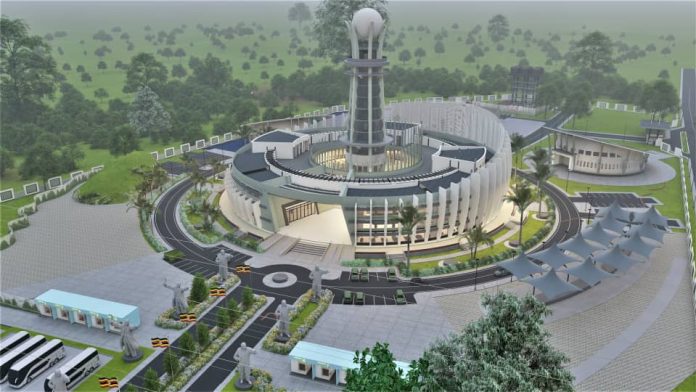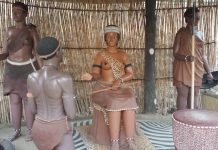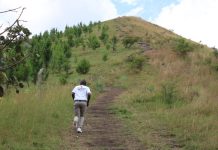In 2020, the President of Uganda, H.E. Yoweri Kaguta Museveni, officially launched the construction site in Katonga, Mpigi District, where the UPDF is diligently working on the Uganda National Military Museum.
President Museveni, during the launch, expressed optimism about the project’s potential. The estimated cost of the museum is Ugx 110 billion, and it is anticipated to become a marvel, significantly contributing to the growth of tourism in Uganda.
The President, during the groundbreaking ceremony, recommended the inclusion of portraits of historical figures like the late Muammar Gaddafi, Julius Nyerere, and Samora Machel at the site, acknowledging their significant contributions to the struggle.
Katonga holds numerous memories of NRA historical figures, and the primary objective of this military museum is to preserve and conserve the rich history of the Uganda.
Harriet Nabunnya, a technical officer from the UPDF, provided insights into the project, stating that the military museum would cover the country’s military history dating back to 1894. She explained that the army would acquire items associated with the military museum from private individuals and recreate what is unavailable based on existing pictures.
In August 2022, an 8-person delegation from the UPDF undertook a benchmarking mission to South Africa. The goal was to gain knowledge and insights from the South African National Defense Force regarding the construction and operation of military museum. This visit is crucial as Uganda moves into the implementation phase of its first military museum at Katonga.
Upon completion, this museum is poised to be the largest military museum in Africa, surpassing those in Algeria and Egypt.
Col. Akiiki, the UPDF deputy spokesperson, expressed confidence that with the involvement of the UPDF Engineering Brigade, the project will proceed as planned without any doubt.
According to Col. Deo Akiiki, the center is expected to significantly boost tourism in the country. It is anticipated that both local and international tourists will flock to the site to marvel at its unique architectural design and the diverse array of items on display.
About the NRA
The National Resistance Army (NRA), the military arm of the National Resistance Movement (NRM), emerged as a rebel force during the Ugandan Bush War or Luwero War. This guerrilla conflict was waged against the governments of Milton Obote and later Tito Okello. The NRA received support from Muammar Gaddafi.

In 1981, the NRA came into existence through the merger of Yoweri Museveni’s Popular Resistance Army (PRA) and ex-president Yusuf Lule’s Uganda Freedom Fighters (UFF). Museveni, then leader of the Uganda Patriotic Movement party, alleged electoral fraud after the disputed 1980 general election and declared armed rebellion.
Museveni, drawing on his guerrilla warfare experience with Mozambican Liberation Front (FRELIMO) in Mozambique and his own Front for National Salvation (FRONASA) formed in Tanzania to combat Idi Amin which led the to victory of NRA against Ugandan National Liberation Army (UNLA) in 1986. When the NRA entered Kampala in 1986, about a quarter of its 16,000 combatants were Banyarwanda, and Fred Rwigema served as its deputy commander, marking the transformation of the NRA into the national army.
Subsequently, the UNLA conducted attacks against civilians in northern Uganda, largely targeting the Acholi people as a form of retaliation for Operation Bonanza, a scorched-earth operation ordered by Milton Obote during his presidency.
From 1986 to 1990, the Museveni regime sought to quell insurgencies and establish control over the army. Despite government claims of defeating the UNLA and other rebel groups, insurgent activity persisted, especially in the northern, eastern, and western regions. In April 1988, 3,000 former Uganda People’s Army (UPA) fighters and members of other rebel groups accepted a government amnesty, surrendering and declaring support for Museveni’s regime. In June 1988, a peace agreement was reached with Uganda People’s Democratic Army (UPDA) commander Lieutenant Colonel John Angelo Okello. Although the NRA integrated many UPA and UPDA members, some rejected the peace accord and continued to resist the NRA.
Following the passing of the 1995 Ugandan constitution, the NRA was renamed the Uganda People’s Defence Force (UPDF).
Why Katonga for National Military Museum
Katonga has a significant history of Uganda wars, playing a crucial role in the military history of Uganda and even in the pre-colonial periods of Bunyoro and Buganda. Katonga Bridge and its surrounding “strategic areas” were pivotal in the sequence of events that led to the overthrow of President Idi Amin Dada in April 1979. In October 1978, Ugandan Army soldiers crossed the southern border and launched attacks in Tanzania’s Kagera region.
President Amin subsequently declared Kagera part of Uganda, as thousands of Ugandans, including soldiers who fled following the 1971 military coup that brought Amin to power, were residing in Tanzania. Additionally, deposed President Milton Obote was in exile in Tanzania. A combined force of the Tanzanian national army (TPDF) and groups of Ugandans initiated a counter-offensive to drive Amin’s army from Tanzania and effect a regime change in Kampala.

Colonel Abdu Kisuule, a senior officer in the Uganda Army, played a key role in containing the invading forces. In February 1979, Masaka fell to the TPDF, and Colonel Kisuule took charge of an offensive to recapture Masaka. Kisuule shared with The Citizen newspaper in 2014 that the plan centered on controlling Katonga, using it as a launching point to push back the invading force.
He recounted that he went with Amin up to Buganzi Hill to see what was happening but when the then president Amin returned to Kampala, the power for operations to retake Masaka was left in his hands. At that time, Lukaya was still under their control, but the soldiers had looted extensively, and the locals had fled. Kisuule strategically set up his headquarters in Buwama, ordering soldiers to stay 500 meters away from the center.
According to Kisuule, around one thousand Libyan soldiers were sent to support President Amin and were deployed in the Katonga and Lukaya areas. The Libyans had joined and they mounted heavy guns which they brought on the hills across Katonga, all facing Lukaya. They also deployed tanks, planning to advance to Masaka on March 9; this was done after briefing the Libyan army at Mitala Maria that had come to boost the ranks.
In April 1979, Tanzanian forces and the UNLA forced out President Idi Amin, leading to a weak UNLF government. Internal divisions within the UNLF and power struggles ensued. Yoweri Museveni initiated the Ugandan Bush War in 1981, forming the National Resistance Movement (NRM) and the armed wing, the NRA. By 1985, the NRA faced defeat and Museveni briefly retreated to Sweden.
A coup in July 1985 forced out President Obote, replacing him with General Tito Okello. The new regime sought negotiations with anti-Obote rebel groups, including the NRM. Museveni returned to East Africa to rebuild the NRA.
Tito Okello attempted to lift the siege, but the Battle of Katonga Bridge in early December failed. The UNLA garrison faced dwindling supplies, resorting to eating rats, with incidents of cannibalism reported. Starvation and unsuccessful attempts to airlift supplies led to desperate conditions.
In August, the NRA launched coordinated attacks, capturing significant territory. The strategically important town of Masaka, with its large market, coffee trade, and road network, became a target. The NRA believed capturing Masaka would facilitate an attack on Kampala. The town was defended by 2,000 to 3,000 UNLA troops.
The NRA’s Mobile Brigade initiated the siege on September 24. Despite the well-fortified UNLA barracks, including minefields and heavy weaponry, the NRA persisted. Counter-attacks by the UNLA’s Masaka Mechanised Regiment were unsuccessful. The garrison’s breakout attempts were thwarted, and by November 18, the UNLA’s commander, Lieutenant Colonel James Tibamuleka, was killed.
As the UNLA garrison weakened, indiscipline and ethnic factionalism increased. Groups of UNLA troops surrendered from December 2 onwards. The NRA heavily shelled the remaining forces from December 4, and on December 10, the rest of the garrison capitulated. The NRA took thousands of UNLA troops prisoner and seized weapons from the armory.

Following the battle, the NRA redeployed forces, and Masaka suffered further damage. Many UNLA prisoners, including Captain Ojara, switched allegiances and joined the NRA. The capture of Masaka solidified NRA control in the central and southwestern regions, setting the stage for the eventual capture of Kampala in January 1986.
Regrettably, the war did not unfold as planned for Colonel Kisuule and his men as the fighting was so fierce, and many men were killed, with tens of jeeps ferrying dead bodies from the frontline to Kampala, further, he said that this was the last serious battle and they lost the war.













